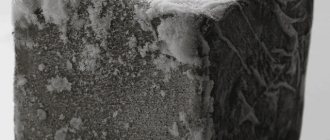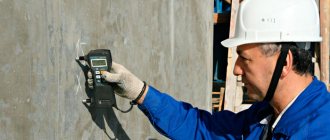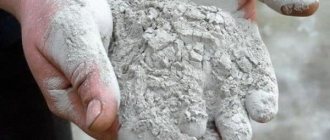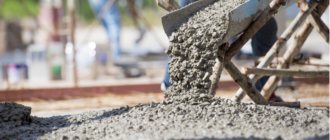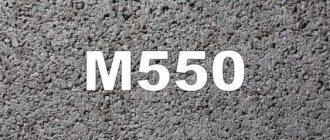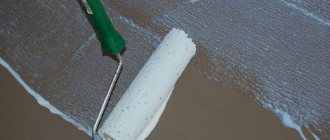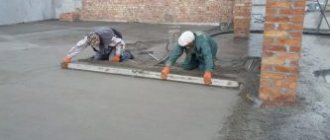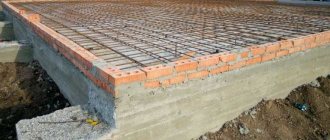The modern building materials market offers a wide range of building materials and services for its users and clients, moreover, the production of building materials has advanced so far that traditional technologies and elements have been left somewhere far behind.
Construction elements such as concrete mortars and mixtures are no exception to such building materials.
What concrete is best to use when pouring a foundation?
The process of mixing concrete for a foundation is not difficult. If the amount of mortar that needs to be prepared is small, then you can mix it without even using certain construction equipment. To do this, you only need a small container in which the solution will be mixed, as well as a stirring device (often a regular drill with changing attachments).
If you need to mix a large amount of concrete solution, then for these purposes it is necessary to prepare a large vessel, which can be used for mixing during cooking.
Very often such a device is an ordinary bayonet or shovel. The advantage of such a shovel is that you can prepare a high-quality concrete mixture without purchasing expensive specialized devices.
The only disadvantage of manually preparing a concrete mixture is rapid fatigue, because it is not so easy to mix a heavy solution with a shovel. Moreover, for high-quality preparation of this mixture, it is necessary to select the appropriate components suitable for the concrete solution.
Concrete mortar is a commercial mortar mixture that acts as a binder among other materials, as well as a major component in some building applications.
The construction concrete mixture consists of four main components, which are arranged in appropriate percentages:
- cement;
- crushed stone;
- sand;
- water.
There are other mixtures that are based on the same admixtures, for example, expanded clay concrete. Expanded clay concrete is a mixture of cement, water, expanded clay and sand. It is not difficult to guess that this mixture is distinguished by the absence of crushed stone in its composition.
In order to calculate the amount of water in a concrete mixture, you need to take into account some parameters of the initial components of concrete:
- Humidity of crushed stone.
- Sand moisture.
- Brand of cement.
- The amount of prepared concrete mixture.
It is worth mentioning in advance that when pouring the foundation with concrete mortar, it is necessary to use a grade of mixture M-300 or M-200.
To prepare a concrete solution, you need to use the following types of components:
- Water.
- Cement.
- Gravel or crushed stone.
- Cement.
- Sand.
If we take everything in 10 kilogram form, then the proportions of these components are as follows:
- you need to take 10 kilograms of cement
- sand - 30 kilograms,
- crushed stones or gravel about 40-60 kilograms.
In order to obtain high-quality concrete grade 300, you need to use approximately half of the total volume of solution used as water. If you adhere to these calculations, you will get a completely high-quality concrete solution for pouring the foundation.
If you couldn’t get the water level right, then in any case you can add it slightly and make the solution a little thinner.
In order to correctly calculate the volume of concrete solution required, you need to know the parameters of the trench for the foundation, as well as the required height of the upward indentation from the ground. It is worth noting that the calculation of a cubic meter of concrete solution must be done separately, by tape.
In other words, if the length of the trench is 10 meters, the height is 1 meter, and the width is 0.5 meters, then with simple mathematical calculations it can be calculated that the volume of the mixture will be approximately 5 cubic meters of concrete.
In addition, for different purposes, the methods of making a concrete mixture are different. For a pile foundation, use a grade of concrete not lower than M-400, and for a conventional columnar foundation, a grade of concrete M-200 will be sufficient.
Composition of concrete mixture for foundation
If the construction of the foundation takes place on a monolithic basis and a type of concrete composition, then for such purposes a special type of concrete mixture is often used, which involves the use of expanded clay or crushed stone.
Crushed stone, as a heat-retaining substance, allows you to make the walls of the house quite warm, and due to the porosity of the material, excellent sound insulation of the walls is ensured. The preparation of a solution with crushed stone components differs both in its composition and structural components.
Their ratios should be approximately the following; for 1 bucket of cement use:
- 3 buckets of crushed stone,
- 2 buckets of sand,
- 2 buckets of water.
If the prepared solution is dry, it may be slightly diluted with water.
Marking: class and characteristics
As mentioned above, each type of construction work uses its own type and marking of concrete mortar. Today, there are a lot of different ways to produce one or another concrete solution for various construction structures and works, and this point especially concerns the pouring and installation of the foundation of a particular construction project.
Among other things, when talking about concrete mixture, it is worth mentioning its classification.
Concrete mortars are divided into grades of a certain qualitative ratio of all building components that are included in the mortar.
Thus, the following markings of concrete solutions are subdivided:
- Concrete grade M-200;
- Concrete grade M-300;
- Concrete grade M-350;
- Concrete grade M-400;
- Concrete grade M-500.
It is worth noting that the classification of concrete directly depends on the brand of cement and its proportion in the solution.
Choosing the right concrete grade
What brand of concrete is the most optimal for building a bathhouse foundation? According to most experts, M350 concrete is the most acceptable. It is used in most cases in private construction. This includes private houses, a bathhouse, greenhouses, and so on.
The numbers in the brand name were not chosen by chance. They indicate the permissible strength limit for the compression process, which is measured in kg/cm2. There is another classification system according to which this concrete can be designated as B25. This parameter indicates the maximum resistance at which pressure, measured in megapascals, is withstood.
Today this is the most popular and in demand brand of concrete in construction, which is ideal in most cases. If you decide to use this type of concrete, you will get a foundation for a bathhouse that has a completely acceptable level of strength for this structure. In addition, such a foundation is durable.
Sometimes the choice may fall on concrete with the M200 grade, and such a structure will also be quite durable and reliable. However, using the M350 brand, you can be more confident about the foundation of your bathhouse.
The grade of concrete for the bathhouse foundation is determined based on the following factors:
- Load. The heavier the future structure, the higher the grade required.
- Soil type. For reliable soils, such as sandstone or rocks, grades M150 or M200 are used. For construction on loams, M350 should be used.
- Type of base. Since the requirements for slab and strip foundations are different, the mortar used for their construction is different.
- Condition of groundwater. This indicator determines not so much what kind of concrete is needed for the foundation of the bathhouse, but whether it is worth adding waterproof additives to it.
Before laying the foundation of a bathhouse, it is better to carry out geological work to determine the depth of groundwater and the type of soil. If this is too expensive or difficult, you can talk to your neighbors who have already built - they can provide the necessary numbers. To choose the right brand of concrete for the foundation of a bathhouse, you should pay attention to the type of foundation and the condition of the soil. If you are lucky, you will be building on dense, homogeneous soil or rock. In this case, a shallow foundation is sufficient, and the best brand of concrete for a bathhouse will be M150. On sand with an aquifer level located below the soil freezing line, a simple strip foundation is usually installed, for which the M200 brand is used. Movable soils in areas where water rises high require more serious foundations, and it is better to choose concrete grade M250 or M300. Unevenly subsiding heaving soils require an increase in the strength of the foundation, so it would be better to order ready-made concrete grade M350. The even more durable M400 is used in wetlands. If the load is expected to be high, it is also recommended to increase the amount of reinforcement, and if the water level is high, it is necessary to take care of high-quality waterproofing.
Using concrete for foundation piles
There are a large number of types of foundations for constructing foundations for pile frames. The most common of them is traditional concrete mixed with crushed stone. The peculiarity of pouring such a foundation is that it is possible to pour it vertically.
This factor makes the pouring process much faster; moreover, the concrete mortar mixture for such a foundation is practically no different from a standard mortar with a ratio of 1: 2: 3 (water, sand, crushed stone).
It is noteworthy that pouring this type of foundation requires a certain holding distance between the piles. For this reason, excavation of trenches for the foundation must have certain distances.
For a house with a small perimeter and area (approximately 90 square meters), this distance should be at least 2 meters.
The process of digging a trench deeper is also more complicated, unlike horizontal digging. For these purposes, you can use a special drill or construction machines that can make a hole to a considerable depth.
The depth of the trench depends on the location of the house. Optimally, the standard depth of a pile foundation is 2 meters. This level is the threshold level for soil freezing in central regions of Russia.
Concrete for the foundation of a bathhouse
The difference between this concrete is that it does not require a deep enough trench. 50 centimeters deep will be enough. Roofing felt waterproofing is placed at the bottom of such a pit, and only then the process of pouring the foundation occurs.
Removing the sand cushion is not at all necessary for the foundation of the bathhouse. The composition of concrete can be varied, and to strengthen its bond, you can use fragments of brick or concrete, diluting the mixture in the trench with them.
The composition of concrete can be with the following ratios:
- Water (2 buckets).
- Cement (1 bucket).
- Sand (3 buckets).
- Crushed stone or expanded clay (4 buckets).
It is noteworthy that it is best to make the solution thinner so that every crack is saturated with concrete.
Concrete for the foundation of the fence
The trench for the foundation of the fence can be as deep as 2 shovels. It is noteworthy that it is best to put waterproofing at the bottom of the trench, since frequent rains can erode the layer between the soil and the foundation.
Waterproofing is placed on all 3 sides of the trench (sides and bottom). It is noteworthy that the composition of the concrete mixture must be concentrated. In other words, you need more cement and crushed stone
The proportions are as follows:
- Water (1 bucket).
- Cement (2 buckets).
- Crushed stone (4 buckets).
- Sand (2 buckets).
You can use bitumen stone and other additional components to strengthen the bond. The main thing is that the solution is not too liquid, otherwise all the concrete will be sucked into the ground.
The fence can be installed either along the entire length of the trench or on individual posts. For this reason, you need to select and calculate the process of installing the fence frame in advance.
Tape
The reliability of the structure can be guaranteed by a strip foundation. Here the choice of brand will range from M150 to M250. It will ensure the strength and stability of the fence.
The length and width of the strip base must fully correspond to the dimensions of the fence. Its depth does not exceed 500 mm. Metal pipes are driven into the bottom of the dug trench, which will serve as a frame for brick pillars or supports made of blocks. The base part of the fence is created using wooden formwork, as in the photo. Concrete is poured into it and compacted to avoid the presence of voids. After the mixture has completely hardened, the formwork is removed.
The M250 mixture is used in the case of the construction of particularly massive fencing, which is created from heavy materials. It is customary to use crushed stone as a filler for this concrete mixture, which can be gravel, limestone or granite. The M250 has a high cost, which is completely justified. Using the M250 mixture will provide a reliable base for a large, massive fence.
Columnar
This is the simplest and most economical type of foundation. A columnar foundation consists of several pillars made of wood or stone. It has a high assembly speed, but has low seam strength. Therefore, a monolithic columnar type of structure will be more reliable than a prefabricated one, but it should be laid in low-moisture soils in the complete absence of water in the wells.
When laying such a foundation for a fence, you should always study the type of soil, the depth of its freezing and the presence of groundwater. Only after a thorough check of the soil can you begin to fill it. As a rule, in this case mixtures M300, M400 are used.
M300 provides high reliability and structural strength. As compression tests using hydraulic equipment show, a structure made using M300 can withstand pressures of up to 300 MPa.
The M400 brand is distinguished by maximum strength and an ideal price-quality ratio. Today this is the most popular type of mixture, which fully justifies itself. Due to its excellent moisture resistance, it does not require the use of waterproofing additives. M400 consists of water, crushed stone, sand and cement, which are combined in a certain proportion to ensure maximum strength of the object. Setting occurs much faster than in other mixtures, which is due to the high cement content. In the photo you can see each type of base.
To obtain the strongest possible foundation for a fence, you should pay maximum attention to studying the area for construction and observe proportions when making the concrete mixture.
Concrete for garage foundation
For this type of foundation, you can use both strip and block types of structure installation. Of course, a strip foundation will give greater density and durability, but in terms of speed of production, a block foundation wins significantly.
In general, the concrete mixture is practically no different from that used in other small-sized structures, for example, in bathhouses. Therefore, the concrete solution for the foundation has some similarities with other mixtures in terms of components. Expanded clay concrete can be used to fill a warmer foundation.
Its components and their contents are as follows:
- Water (3 buckets).
- Cement (2 buckets).
- Expanded clay (4 buckets).
- Sand (2 buckets).
To improve the bonding and plasticity of the solution, plasticizers can be used, but their cost is quite high.
It is worth noting that the trench under the garage foundation should not be deep. The standard value is 70-90 centimeters deep.
The concrete mixture is poured onto a sand cushion 15 centimeters thick from the soil.
Which brand of concrete is best for pouring a garage foundation?
When building a garage, different materials can be used, the choice of which determines the type of foundation and the requirements for its strength. Garages come in a variety of sizes, from lightweight sheet metal to heavy brick.
When buying ready-made concrete mortar for building a foundation for a garage, it is recommended to choose the following brands:
- M300 - for stone or brick walls (base depth - more than 0.5 m);
- M250 – for a garage base made of wood or on a wooden frame;
- M200 - for garages built from concrete blocks (cinder blocks, foam concrete, sawdust concrete, etc.);
- M150 - for buildings made of iron sheets (foundation depth - 0.3 m).
If the garage has a basement, then, regardless of the type of structure, you need to use M300 concrete with increased water resistance .
Requirements for pouring
The ratios of all components in the concrete solution for the foundation of a particular structure should also be taken into account so that in the future a break or crack does not occur as a result of an incorrect percentage of elements.
It is stipulated that there should be one part of cement, four parts of crushed stone, two parts of sand, and half a part of water.
Of course, this ratio is close to ideal, but in reality it often does not correspond to the indicators and this is normal. After all, many factors influence the percentage of components, for example, the brand and number of cement, the structure of sand, and the use of special plasticizers in the solution.
For example, if you use cement under the brand M-500, then the concrete will be considered grade M-350, if you use cement grade M-400, then the concrete, accordingly, will become grade M-250.
The use of cement and water in preparing a concrete mixture is the most important task of every builder. Without these structural components, it is completely impossible to produce concrete. For this reason, it is necessary to observe the percentage of each of the components as strictly as possible in order to subsequently obtain a guarantee of solid and indestructible concrete.
When mixed with water, cement is able to acquire a distinctive feature - instantly harden.
Buying concrete
In the event that concrete production cannot be carried out independently, then a fairly convenient delivery service for the finished solution can be used very quickly. Basically, the price of such a concrete solution is calculated based on cubic meters of the mixture.
Thus, the optimal price characteristic for one cubic meter of M-400 concrete mix is 5,500 rubles . Of course, this amount is quite relative and varies depending on the subject of Russia, as well as on the components and conditions of production of the mixture.
This type of concrete is delivered in special trucks with a rotating drum. The volume of concrete delivery per truck can be 4-7 cubic meters.
The difference between prices varies greatly depending on the brand of cement and the brand of concrete. Thus, the cheapest brand of concrete m-200 per 1 cubic meter is equal to 2800 rubles .
It is worth noting that payment for such a service is made not only for the concrete solution, but also for downtime of the machine during operation and draining of concrete.
It is noteworthy that absolutely any concrete mixture can be produced and delivered, which will be specified when ordering a machine with a solution.
Types of foundations for a fence
There are many designs of fences, but they all have something in common. What they have in common is that they all stand on only a few types of foundations. Of course, depending on the complexity of the structure, parameters such as the depth of the foundation for the fence, the diameter or cross-section of the piles (pipes), the depth and width of the base of the foundation for the fence may differ. What do these features depend on, you ask. We answer that such engineering design features, as in the construction of a house, are calculated depending on local conditions. Of great importance is where the fence will be built, in what climatic conditions, on what type of soil and from what materials. Let's list the few ways to create a foundation for a fence, the price, the difference. But we recommend that you rely primarily on quality and reliability rather than on the price of the foundation for the fence.
- The pipe is inserted into a hole made in the ground and filled with sand and crushed stone. The gaps are filled with stones and rubble. After this, the hole is compacted.
- The same holes are drilled as in the previous version. A pipe is inserted into these wells, but instead of crushed stone, the hole is filled with concrete.
- The formwork is installed, and a pipe is installed into this formwork. Then the concrete is poured and the material is allowed to set.
- They use special screw piles instead of pipes. Piles of a similar design can also be used in the construction of a foundation for a house. Read about the pros and cons of pile foundations and screw piles in the previous article.
- Initially, the pillars are concreted. And then a grillage is made between them. To ensure sufficient strength of the tape, the grillage tape is reinforced. An air gap is formed under it.
- A shallow strip foundation on supporting pillars is used.
- Install the strip foundation to the freezing depth.
Types of installation of fence posts
Is it expensive?
We have specifically arranged the previous list of design types in order of increasing cost. Those. building a foundation for a fence, the price of which ranges from the lowest - the first point, to the highest - the fourth point on the list. Of course, little depends on simple desire, and the choice of foundation construction usually depends on what type of soil the construction will be on and how deep the groundwater lies. But there are exceptions; if the soils are capable of draining water well, and the groundwater level is below the freezing depth, then you can choose and install any type of foundation for the fence, the price of which comes to the fore. But it also happens that the groundwater is high, and you are planning to make a permanent fence, for example, from brick or rubble. In addition to everything, the soil is also weakly stable, for example, clay or loam. This is where you have to think about a serious reason, which is, of course, much more expensive.
When you start building a fence and suddenly you haven’t done engineering and geological surveys, which we definitely recommend when building a house, and you don’t know the level of groundwater. That is, one old proven method. You begin to dig a pit near the future fence. Its depth should be 50-80 cm below the freezing depth in your region. This information can be found on the Internet, here is a good calculator. So you are digging and have already reached this level and still don’t see any water, this is good news for you. You are lucky, you can choose and install a fence with a base of any design.
Limits of soil freezing in the Russian Federation
Adviсe
To ensure that the preparation of the concrete composition does not complicate anyone, I would like to formulate a few simple tips that can help in the production of a high-quality mixture:
- You need to use cement of an order of magnitude higher grade than the grade of the desired concrete.
- In order to load concrete building components into a concrete mixer, you do not need to measure with a shovel. It is best if buckets are used for this.
- After preparing the solution , you need to let it sit for a couple of minutes.
- There is no need to make the mixture dry or, on the contrary, very liquid . The composition of the resulting solution must be plastic.
- In any type of concrete solution , the first step is always to pour water into the concrete mixer, then cement, and then all the other components.
- Each time, after the process of making a concrete mixture , it is necessary to wash all the equipment and let it dry.

